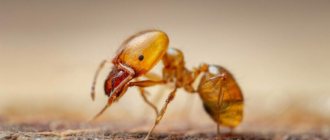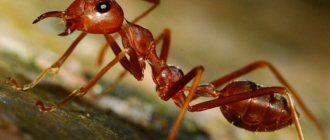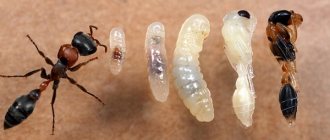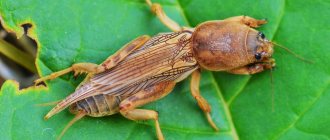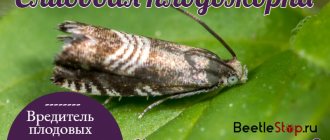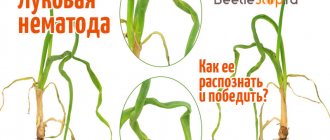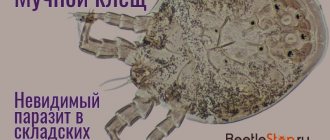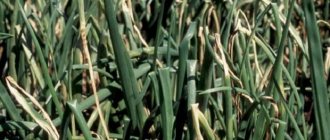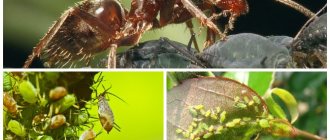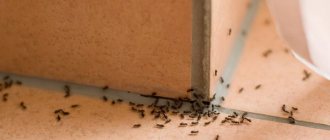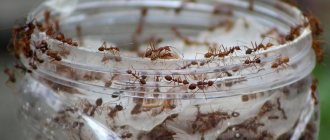Description of ants
Houses made of wood are environmentally friendly; they are warm in winter and cool in summer. But sometimes uninvited guests move in with the owners. And if rats or mice cause obvious harm, then carpenter ants at first glance may seem harmless. But actually it is not. Typically, representatives of this species live in the forest. They don't bother anyone there. But often these insects build their anthills near their homes. And it doesn’t matter what a person built his house from - brick, clay or concrete. Although most often ants settle and build their nests near wooden structures. They use wood as a building material for their house. A large number of passages made inside the tree make it loose. The ants undermine the lower logs, causing the house to slowly but surely collapse.
The red-breasted carpenter ant is quite large: the body length of males reaches 12 mm, and females are slightly larger - 15 mm. The body color is brown or black, the chest is red. The ant's body is divided into segments. The abdomen is oval, and the chest is thin, cubic in shape with smooth curves at the top. A pair of antennae, antennae and large jaws are visible on the head. Females differ from males in the presence of wings, which they shed after mating. Sometimes males may also have wings. The majority of carpenter ants are workers. They find building material and drag it into the anthill, doing construction work.
Ants of Russia
More than 300 species of ants live in Russia. The most common are: wood ant, garden black ant, carpenter ant and harvester ant.
Forest
There are several varieties of this type:
red forest ant. This is a fairly large insect, 7-14 mm in length. The body is dense, the head is large, the abdomen and back of the head are black, the rest of the body is orange. Inhabits coniferous, deciduous and mixed forests. Hardworking builders. The anthills they build sometimes reach 2 or more meters in height. Forest red ants prefer to live in one family, which means that the female that flies out (nuptial flight) from the nest after fertilization does not build a new colony, but returns to her family. A compartment in the nest is allocated for the queen, where she breeds new offspring. The number of one anthill of red ants can reach up to a million inhabitants;
Black garden (lasia)
Small insect. Its length is 3-5 mm. The color is black. Garden ants build nests in old rotten trees and soil (mound). Their queen, after the mating flight, does not return back to the anthill, but creates a new colony, and independently, without the help of worker ants. The queens of this species have the longest life expectancy - 28 years.
Woody
Belongs to the genus Campotonus. The territory of the Russian Federation is mainly inhabited by black and shiny wood borers. Woodworms are quite large in size, their length can reach 11-12 mm. They inhabit mainly deciduous and coniferous forests. To build nests, they prefer old, fallen trees, rotten stumps or dried branches. They rarely descend to the ground. They live in small families with a single queen.
The number of one colony is approximately 5-8 thousand individuals.
Reaper ants
Their body length varies from 5 to 10 mm. They have a large head and well-developed jaws, which they need for grinding seeds and grains (the main diet of reapers). Harvester ants live in large colonies. Nests are built underground. Most often their settlements can be found on roadsides or in fields. The young queens and males of these individuals usually overwinter in the anthill, and with the onset of spring (while the soil is still wet) they fly out of the nest to establish new colonies.
Signs of ants in the house
Carpenter ants leave behind traces of their vital activity - wooden dust, which looks like flour. It is a building material for insect nests. It is easiest to notice early in the morning or evening. It is then that they begin the period of collecting building materials. Dead insects are often found among the dust and sawdust.
Ants move through the developed territory one after another, so they are easy to spot on the floor or near the walls of the house.
By following these hard workers, you can quickly determine their favorite place. Proof that carpenter ants have settled near the house are rather large white eggs hidden in the nesting box. If the rot is located next to a wooden building, carefully inspect the walls of the house and pierce the walls with a thin screwdriver. This will help detect passages inside the tree.
Sometimes woodworms build an entire colony in the vicinity of a house. In this case, they lay paths between individual nests. Sometimes they can pass through the territory of the house. They easily penetrate there through microscopic cracks.
Major pests
Wooden houses are often inhabited by three types of wood ants: red-breasted, black and odorous. Other carpenter ants can also live in walls, but these ones, due to their omnivorous nature, appear directly in living quarters and are easy to notice.
The largest carpenter ant
Red-breasted carpenter ants
The red-breasted carpenter ant is the largest of all insects of the family living in Russia. Red-breasted carpenter ants can reach 2 cm in size.
An ant can live not only in dead trees, but also gnaw through living wood. Well-dried logs, used for the construction of walls in a wooden house, are not a barrier for this insect. This ant does not feed on wood. It gnaws holes in trunks and log walls, making its nest there. Red-breasted woodborers live in colonies, the number of which can reach 10 million individuals. By gnawing holes in a tree, these insects are capable of making one shell with a rotten core from a high-quality solid log within a year.
Having settled in the house, red-breasted woodborers look for food indoors. Like other ants, red-breasted carpenter ants pick up leftover food in the kitchen and are very greedy for sweets.
Females and males of this species have wings and can migrate a considerable distance in search of a place for a new nest. Working individuals of all castes are wingless.
Black wood borer
Black wood borer
Outwardly similar to the black garden ant, but differs in its large size and very large head. Females and soldiers of this species reach 1.5 cm in length. The head of the black woodworm is wider than the abdomen.
The black carpenter ant lives in rotten wood of forest trees. It rarely attacks houses, since there is no suitable habitat for it. But if the house begins to rot, you can expect ants to appear. When planning to fight this species, you need to take into account that in the Vladimir and Vologda regions these insects are included in the Red Book.
Smelly guest
Odorous carpenter ants
The validity of the name of this species is disputed. They say that the odorous carpenter ant got its name from its pungent “non-ant” smell. But inquisitive researchers, poking around in the anthills of these insects, did not notice any smell.
Odorous carpenter ants are a small species of ant and can easily be confused with common black ants. The odorous one also has a black body color, but a larger head and abdomen with light stripes. But the latter is visible only with magnification.
The size of females of this species is 8 mm, males 4 mm and workers 4-5 mm. There can be several females in one colony.
Scented woodworms feed on the honeydew of aphids, which they breed in their anthills. Nests are made in hollow trees, chewing rotted wood to the state of very fine sawdust and gluing the resulting mass with saliva. When finished, the building material looks like “cardboard”, similar to that made by distant relatives of ants – wasps.
Shiny carpenter ant
Shiny carpenter ant
Insects of medium size: females 1 cm, males 0.7 cm, workers 0.5-0.9 cm. Body black, shiny. The head is large.
Lives in dead wood and living trees. In nature, it hunts small invertebrates and collects aphid honeydew. The diet of this carpenter ant is protein-carbohydrate, so having chosen a wooden residential building as a nest, the insects will begin to pick up leftover food from a person’s table.
Where to look for ants
- Woodworms settle in damp wood because it becomes soft when exposed to water. It is much easier to make holes in such material. Therefore, they are investigating the places where the sewer exits.
- Check existing door mats.
- They inspect the foundation and courtyards.
- They look for woodworms in the grass, lawns, and under bushes.
- Explore the area around young trees. It is usually covered with a thick layer of damp mulch or leaves in which ants like to live. To find them, rake the mulch and inspect the ground.
- Woodworms can live in compost heaps. Sometimes they settle in floors and in potted plants.
How to prevent ants
There is no need to wait for ants to appear in the house. Every possible measure should be taken to prevent them from appearing.
For this purpose, branches that bend close to the windows are cut off. All flowers, vegetables and fruits are inspected and shaken off so as not to bring insects into the house. You cannot leave heaps of garbage, branches, or last year’s leaves on the site. They can become a haven for carpenter ants.
The inside of the house must be kept clean, the floors washed frequently, and the trash can covered. You cannot leave unwashed dishes. Windows should be covered with nets; doors should not be left open.
If there are ant heaps nearby the site, the danger of them moving into the house increases. To scare away uninvited guests, you can scatter substances with a pungent odor. These are essential oils, pepper, turmeric, cinnamon.
Damage caused
Every second person considers ants to be extremely harmless and beneficial, because they eat weak insects and destroy the bodies of dead living beings. But black ants bring not only benefits to the site:
- they grow aphids, which draw juices from plants;
- spoil the lawn;
- harm the roots and leaves of plants, gnaw edible root vegetables and sweet berries, spreading their acid to them;
- They spread bacteria that stick to their paws throughout the area, infecting plants and soil.
Domestic black ants are also dangerous:
- bring pathogenic bacteria from places where garbage accumulates, toilets and technical premises into the apartment;
- spoil food;
- they store food throughout the house, which spoils over time, which creates conditions for the appearance of mold fungi;
- They collect unnecessary garbage, excrement and food scraps outside their home, but on the territory of the apartment.
If you suddenly see even one insect, immediately begin getting rid of unnecessary neighbors.
How to find a nest
How to get rid of carpenter ants? First you need to find their nest. To do this, you need to monitor the movement of insects along the paths they have designated. They will show traces of dust carried by large black ants. The woodworm lives in damp trees, lying posts, and boards, leaving noticeable winding passages on them. Near the nest, the amount of dust increases significantly.
You can also look for places on the tree where the wood is most damp. This is where carpenter ants like to place their nests. How to get rid of them?
Black carpenter ant (Camponotus vagus): distinctive features
You can identify an insect by its color and size. Despite this, representatives of this species are often confused with other ants that live in forests.
In addition, the insect has a physique extremely similar to its close relative, the red-throated carpenter ant.
External characteristics
The black carpenter ant (Camponotus vagus) is large: body length of females is 1.5–1.7 cm, soldiers are slightly smaller than females, males are 1–1.2 cm, workers are 0.6–1.3 cm. Color black , glossy, without mixing other shades. The antennae are geniculate. The eyes are medium-sized, black. The head is large and wide. The abdomen has light silvery hairs. The lower edge of the clypeus is straight.
The eggs are small and elongated. The color is white, often with a slight hint of yellow. Insect larvae have pronounced segmentation. The body color is similar to eggs. The body is shiny, translucent.
Spreading
The black carpenter ant lives exclusively in forests. You can find this insect in Europe and Northern Asia: in Crimea, Western Siberia, Kazakhstan, Turkey, the Urals, and the Caucasus. It also lives in northwestern Africa.
Under unfavorable conditions, ants hide in underground passages. Give preference to deciduous trees. The largest populations are observed in areas with high humidity.
How to deal with woodworms
There are several ways to control woodworms. Which one to choose depends on several conditions.
Chemical and natural insect repellents can be used. It is better to use organic folk remedies near home. Especially if there are children and animals there. But in some cases, chemicals have to be used in inaccessible places.
You can do something radical and destroy the ant nest. If you do this soon after they move in, they will leave. But they can move to another place or settle into several colonies, creating new problems.
Special baits are very helpful in the fight against ants. Their action is prolonged and more reliable.
You need to be careful not to get ants on your hands. In a calm state, they do not harm humans. But if the nest is attacked, they begin to bite painfully. The burning sensation is further enhanced by the fact that they inject formic acid into the wound.
Reproduction
The reproductive function is assigned to the queen uterus. Tropical arthropods are distinguished by the presence of only one queen, but other subspecies may have several queens. Large winged females mate with males on their first flight. The stored sperm is used throughout the life of the uterus.
Adult fertilized queens shed their wings. Then it is protected by working individuals. When moving, the female is distinguished by a cylindrical elongated abdomen; after hundreds of thousands of eggs begin to mature, it becomes larger. Before the stationary phase begins, the larvae become cocoons and do not require food, which is why all the food they obtain is presented to the queen.
The presented insects belong to the class of Hymenoptera, which have a full cycle of transformation. That is, their life begins with an egg, then larvae appear. Arthropods turn into adults after the pupation phase. Eggs are formed at the beginning of the period of sedentary life. The female is characterized by fertility of up to 300 thousand individuals. The duration of the embryonic period is 3 weeks. Before migration begins, larvae are born.
The development of pupae is also a synchronized process - the cocoons of the previous clutch of eggs turn into adults. To feed the larvae, the family begins migration, and by the beginning of the pupation process they find a site.
Every year, the queen of the colony produces a special type of clutch, after which females and males with reproductive function are born. After some time, they leave the family and form their own colony.
Mechanism of action of toxic bait
If it is difficult to get to the nest, toxic baits are installed near the insects’ home. It’s a good idea to mix their contents with sweet foods. The ants, having discovered the “treat”, try it themselves and bring it into the anthill. There they infect their brothers, as a result of which they die. Three days pass from infection to death.
Nowadays, gel baits are popular, for example “Anteater”, “Clean House”, “Great Warrior”. They are mixed with jam or sprinkled with sugar. 3 baits are placed near one nest. It is better to choose those that act slowly. Then the ant will probably have time to get into the anthill and transfer the poison.
Gel baits are very effective. They help get rid of insects forever. Treatment with chemicals should be carried out in a respirator, making sure that they do not get on the skin of the hands and face, or into the respiratory tract. After handling, wash your hands thoroughly with soap.
Nomadic
This type of ant is called nomadic because of the lifestyle of its representatives. Insects do not have their own nest; they constantly travel, stopping only for a while to replenish their population. Then, from their own bodies, they construct temporary housing that resembles a large lump. In its center the queen lays eggs. With the advent of young offspring, the ant family “lifts anchor” and goes in search of another feeding territory.
Nomads are relatively large individuals (their body length reaches up to 15 mm), which is why they often find themselves in the ranking of the largest ants in the world. What catches your eye is the frightening-looking jaws of the insect, the size of which even exceeds the dimensions of the head. The female is larger than the male; during the period of laying eggs, her body size can reach up to 5 cm. Photos of nomads can be seen below.
Nomads are ants
The insects are found in Africa, Central and South Asia, and North and South America. They are called killer ants because the nomads destroy all living creatures they come across on their way. These can be not only small insects; representatives of this species are able to feed even on small rodents and reptiles.
Fight with sprayers
The nest, which is easy to get to, can be destroyed using sprays. A special powder is placed in them - a remedy for carpenter ants. Stores that specialize in means of protection against various pests have a wide selection of such drugs. You can use ready-made sprays: “Dichlorvos”, “Regenta”, “Raptor”. Direct the stream towards the nest. The treatment is carried out several times. It is better to do this in the evening, when all the ants have returned home.
Do not spray paths along which insects move. The drug will scare away the worker ants, who will soon build another path for themselves, and the queen will remain and continue to reproduce.
Remember: such products are highly toxic. Therefore, when using them to combat carpenter ants in the house, you must follow the instructions for using the drug. Do not spray sprays in areas where children or pets can reach.
Chemicals must be used in a respirator and protective suit. Hands are protected with gloves.
Types of insects
Black ants are numerous. The following species are most often found in a person’s garden or home:
- Garden or common (Lasius niger). Its body has a length of 4 to 11 mm. The buildings of this type of ant are especially noticeable in the spring, when the grass is short - there are earthen mounds everywhere. Insects have become comfortable in the city - they build nests underground and crawl out into the sun from cracks in the asphalt. They are most dangerous for the garden because they specifically grow aphids, care for them, and protect their droppings. Farmer ants milk pets and eat their milk, while aphids suck juices from plants.
- Scented Wood (Lasius fuliginosus). The insects are no different in size from an ordinary ant. On the street they settle in a rotten trunk or in the hollow of a tree, and in people's homes they settle in the walls of houses, around pipes and thermal communications. They build their nest from a material resembling cardboard - a mixture of chewed wood and saliva. The odorous ant got its name from the peculiar smell that it emits when it detects food, as well as when it is in danger or needs help.
- Woodworm (Camponotus). Camponotus lives all over the world - in taiga, mixed forests, deserts and semi-deserts. It got its name because of its ability to gnaw holes in (usually dead) wood. It is in danger of extinction, which is why this species of ant is listed in the Red Book. Its length reaches 15 mm. Insects help the forest - they clean it and loosen the soil. However, for wooden houses they become a serious problem: they gnaw holes in the wood, the logs gradually deteriorate, crumble, and the house loses its strength.
- Turf (Tetramorium caespitum). Such insects live in places covered with turf. They are not found only in the Far North. They are able to use cavities underground without external structures, in rotten wood and in the subcrust of rotten stumps for nests. When they get into people's houses, they crawl through the cracks and wander from one room to another. Local elimination of turf ants is almost impossible, since their nests are not clearly visible.
- Black Crazy (Paratrechina longicornis). Individuals of this species move in an incomprehensible order, chaotically. They are located at the bottom of the food chain, but at the same time they manage to annoy other species of living beings, including humans. The bite of a crazy ant causes severe irritation, and these parasites also chew on wires, which damages equipment and equipment.
Use of boric acid
Boric acid is used to combat various insects, including carpenter ants. To do this, mix it with sugar in a 2:1 ratio. The resulting mixture is laid out in small dishes and placed around the nest. Ants go for sugar, and boric acid enters the body with it. It dissolves the insect from the inside. Working individuals bring boric acid into the nest. This way it will get to the females and other inhabitants, destroying them.
Features of the system
The life of lasius niger is to provide the uterus with basic nutrients. Each group of individuals has its own responsibilities:
- breeding offspring;
- anthill protection;
- food production.
The lifespan of females is significantly longer than males. Males die almost immediately after mating. Therefore, the average life of a male lasts no more than a month, and a female lives up to 1 year.
There can only be one queen in one anthill. Sometimes a larger number is possible at an early stage of colony development. Afterwards, the flying females themselves fly out of the anthill, look for places to lay eggs and create their own colony. You can see the differences even by looking at a photo of black ants. Females and males have wings; workers do not have them. The queen initially also has wings, which she later chews off herself.
Big black ants in the garden
The larva of this type of ant is a sedentary worm with a whitish color. After reaching the required age, nurse ants help new individuals to be born. They break the egg.
Folk methods of struggle
If chemical methods cannot be used, they try to use folk remedies:
- Fill the nest with boiling water or vinegar. In this case, a significant part of the ants die.
- Use garlic arrows (put them in an anthill). Insects are afraid of this strong smell.
- A dish with sugar syrup bait is placed near the anthill. Ants crawl into it to feed and drown there.
- They mix yeast with water and sugar or coffee grounds, which kill insects.
- Prepare black soap by mixing 400 g of laundry soap, 200 g of kerosene and carboxylic acid (2 tbsp). Dilute with warm water and fill the anthill. Repeat after 2 days 3 times.
- To destroy an anthill, this method is only suitable if it is located away from home. Fill it with kerosene and set it on fire.
You can use one or more different methods to get rid of carpenter ants.
Brains and muscles are moldy
In the work, the results of which appeared in the article “Behavioral mechanisms and morphological symptoms of zombie ants dying from fungal infection,” scientists examined the dying behavior and morphological changes of infected Thai ants. Scientists note that, as previously described, infected ants are distinguished by “unusual behavior”: they go where healthy insects do not stick their noses - into the forest floor, closer to the green parts of the plant, where they die. However, single healthy ants also sometimes run into the forest floor, but again return to their lair - in the trees, to a height of more than 1.5 meters. Entomologists note that such “vagrant ants” suffer from Ophiocordyceps unilateralis, and those that “stay at home” do not encounter infection and do not get sick.
Infected arthropods roam the forest alone. They stumble, fall, and generally seem to go wherever they want: “The ants begin to experience muscle cramps and cannot control their limbs,” explain the authors of the new study. It is also interesting that insects prepared for death leave the anthill and begin to look for a “grave” in the morning: “Sick ants are active from 9.30 to 12.45,” scientists specify. “They obey the solar rhythm.”
Scientists note that infected ants are not aggressive and do not show interest or a militant attitude towards rivals, wasps and flies. However, predators do not look at them either: “Even spiders do not hunt sick ants,” the researchers write
Biologists have studied the bodies of ants ready to cling tightly to a green leaf. It turned out that at this point the nervous system, blood vessels and muscles of the ant are simply shrouded in fungal hyphae. In fact, while still alive, the ant becomes moldy from the inside. Moreover, Ophiocordyceps unilateralis does not destroy tissue: hyphae entwine internal organs, individual muscles and blood vessels. In this way, the fungal hyphae disrupt the connection between organs and nerve endings. At the cellular level, the fungus causes an energy crisis in cells: the number of mitochondria in the muscles of infected ants decreases.
Scientists explain that all the described morphological and behavioral changes in a sick ant are an adaptation of the fungus, which “tells” what and how to do in order to die in the right place and in the right position. Thus, the fungus “finishes off” the muscle cells at the moment when the ant grabs the leaf. It turns out that the insect cannot open its mandibles (the muscles are paralyzed). So the poor fellow hangs for several hours until he dies. True, scientists cannot yet explain how the ant chooses the site of its dying bite; why he is drawn to greenery and morning activity. “We will try to understand the mechanisms by which fungi manipulate ants,” summarize the authors of the study, the interesting details of which can be found.
Read about the recently discovered new species of cordyceps mushroom.
